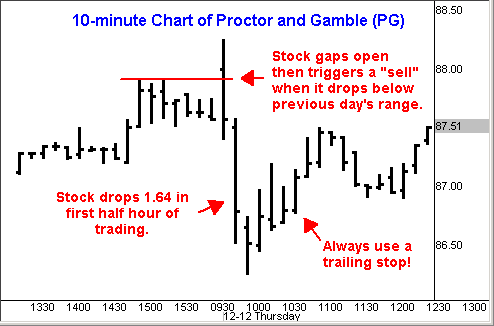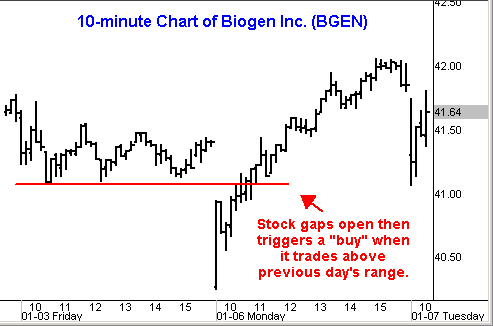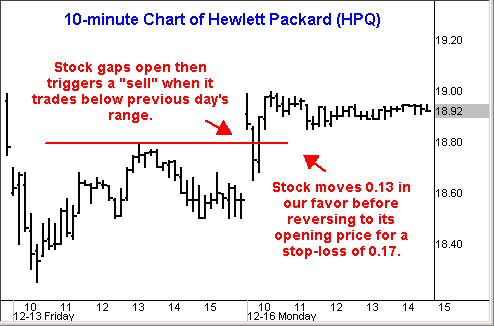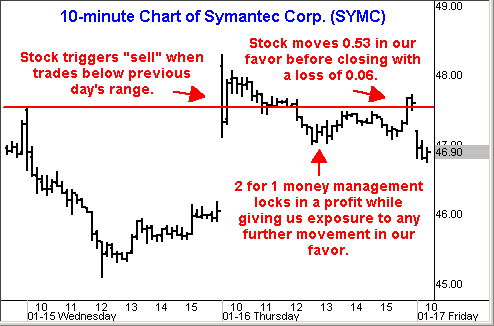Today’s Trading Lesson From TradingMarkets
Editor’s Note:
Each night we feature a different lesson from
TM University. I hope you enjoy and
profit from these. E-mail me
if you have any questions.
Brice
How To Make Money From The News
By Daniel Beighley
TradingMarkets.com
News Reversals is a trading strategy
developed by Larry Connors and first published in
Street Smarts in 1995.
We’ve all see the effects news can have on
the market and individual stocks. Many of us have had the unfortunate
experience of being on the wrong side of the news. News Reversals is a
strategy designed to always put yourself on the right side of the news.
With the News Reversals strategy, we’re
looking for key news on stocks occurring outside of the normal market hours,
then watching for the stocks to gap above or below the prior day’s trading
range. A stock that gaps, then trades back into the prior day’s range will
trigger a News Reversal. Once triggered, the trader has profitable edge
working for him or her.
So why does the strategy work?
A stock that rejects news is speaking very
clearly with the message: “I don’t care about this news.” By stepping in
right when the stock begins to trade into the prior day’s range, we’re
taking advantage of a panic that sets in as the stock rejects the news.
This is what we call trading “counterintuitively.”
Logic tells you that a positive news event should translate into a positive
reaction for the stock, though experienced traders know better. Stocks will
do whatever they want to, and only those who trade with the “herd mentality”
will buy into such events.
The rules for the strategy are
as follows:
- Traders should wait for an extremely
bullish or bearish event to occur after the market has closed. Equity
traders should be looking at earnings reports, takeover rumors, brokerage
house recommendations, and so forth. For futures traders, this can be a
crop report, livestock report, economic report, weather report, etc.Â
- The market must gap above or below the
previous day’s high. On openings that gap lower, place a buy stop one tick
above the previous day’s low. For openings that gap higher, place a sell
stop one tick below the previous day’s high.Â
- After you are filled, stops should be
placed at the lesser of either the morning’s opening price or 1 point. As
price moves in your favor, stops should be adjusted to lock in profits.
Here are some examples:
Proctor & Gamble (PG) — On
Dec. 12, 2002, the company raised its earnings guidance for the second
quarter.
Here PG gapped up on the news, attempted to
move higher, but couldn’t hold the price level and quickly sold off. As soon
as the stock dropped below its previous day’s high of 87.90, it triggered a
News Reversal. We go short at 87.89. The stock had a maximum move of 1.64.
Of course, we don’t always get the perfect
fill due to lack of an up-tick, price gap, etc., so it’s best not to chase
these any more than 0.10 – 0.15 below the trigger price. Also, we can never
expect to capture all of the move, so we’re going to use a trailing stop in
an attempt to optimize our profit potential. We see News Reversals nearly
every day, so it’s best to make a habit of taking the money while it’s
there. Execute like a machine.
Biogen (BGEN) — On Jan. 6, 2003, the
company was downgraded by Salomon Smith Barney to “underperform” from
“in-line.”
Here with BGEN the stock gapped down on the
downgrade, then triggered a News Reversal one hour into the session at
41.09. The stock gave us a maximum move of 0.97 for the day. The price
action here gave us a nice steady climb higher, as it closed well in our
favor at the end of the day.
The decision to hold a position overnight is
up to the individual trader. A stock that closes at the top of its daily
range is more likely to continue higher the next day, although as can be
seen in the example above, this is not always the case. Playing these as
pure daytrades is the more risk-averse strategy. No matter what, always lock
in a portion of your profits.
Hewlett Packard (HPQ)
— On Dec. 16, 2002, the stock was added to Merrill Lynch’s Focus One List.
Like every other strategy with an edge, there
will be times when it does not work. In this example of Hewlett Packard, the
stock gaps higher on the news, triggers a “sell” at 18.78, then moves 0.17
in our favor before reversing back to its open price of 18.91 for a loss of
0.13.
With the stop loss we want to take the lesser
of either the opening price or 1 point. There is no arguing with this rule.
The stop loss is your most powerful weapon when it comes to succeeding as a
trader. Use it properly and without hesitation.
Symantec Corp. (SYMC)
— On Jan. 16, 2003, the company beat its third-quarter earnings
expectations by $0.08 with profits of $0.47 per share.
At times, a trade will trigger, then move
sideways for a good part of the day. This can be a frustrating situation
which calls for patience. In the above example, SYMC gapped higher after
easily beating its earnings expectations. The stock triggered a “sell” at
47.54. In the first 10 minutes, the stock moves 0.43 in our favor, then
quickly reverses and trades sideways for over an hour in “unprofitable”
territory. Eventually the stock gives us another move down for a maximum
potential gain of 0.53.
Managing a trade after it triggers can no
doubt be a difficult task, but keep the perspective that a triggered trade
has an edge on the market, and the goal is to be profitable. Using 2-for-1
money management is a great way to capture gains while remaining exposed to
further profits. With SYMC above, it would have been smart to take some off
after 0.30 – 0.50, then set a stop loss for the second half of the position
at breakeven. Worst-case scenario, you take home a small profit. You can’t
go broke taking profits.
How do I find News Reversals?
By giving the news a good read every morning,
you will find ideal candidates to put on your “hit list.” TM also has a
News Reversal Service, run by me, that selects candidates every morning.
On average we see 1 – 3 stocks trigger a day. If the stock doesn’t gap, it’s
not a setup.
To narrow things down, it is best that the
stock be over $15 in price and trade at least 300,000 shares for average
daily volume. The higher the price and volume, the better. We look at these
trades in terms of point moves, not percentages. Also, stocks that gap over
5% will have less of a chance to trigger.
To sum things up:
News Reversals offer a clear edge for
succeeding in the markets. Some people may be uncomfortable with the idea of
trading against the common logic of a news event, but remember, it’s the
“herd” that most often gets exploited in the market.




